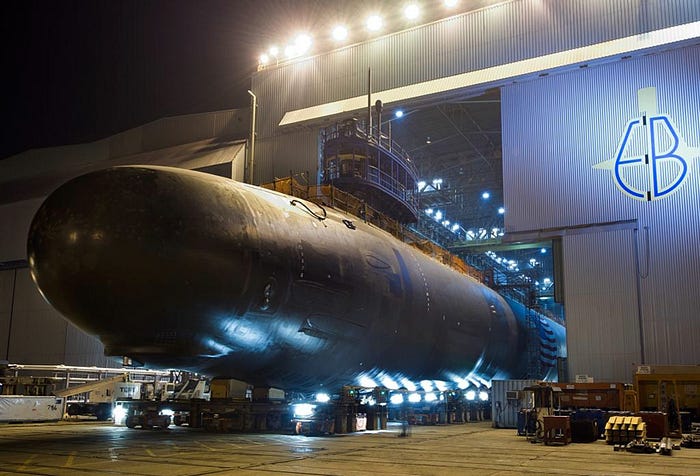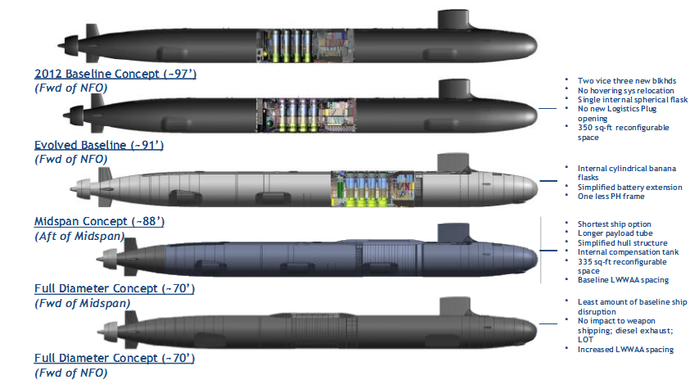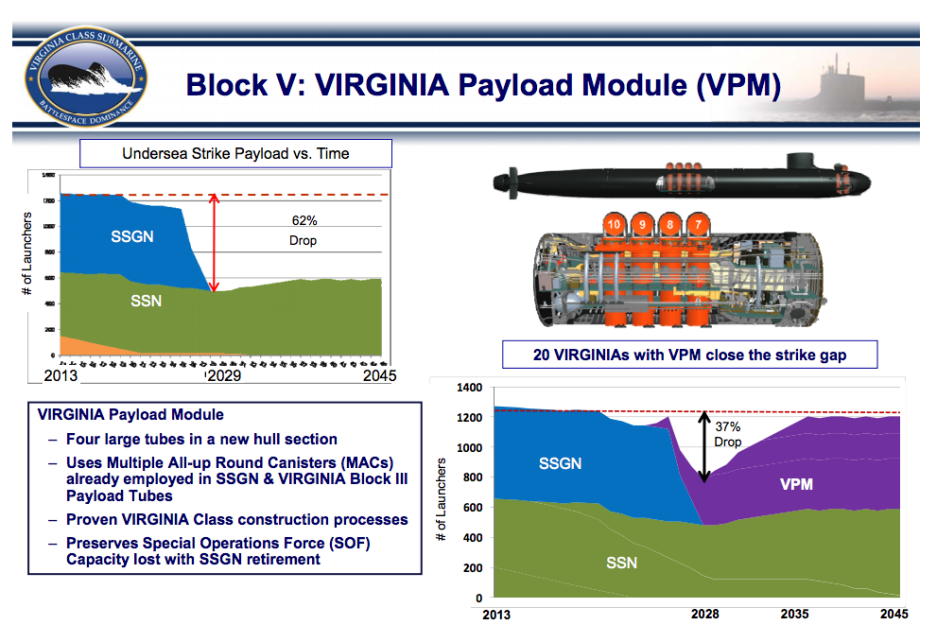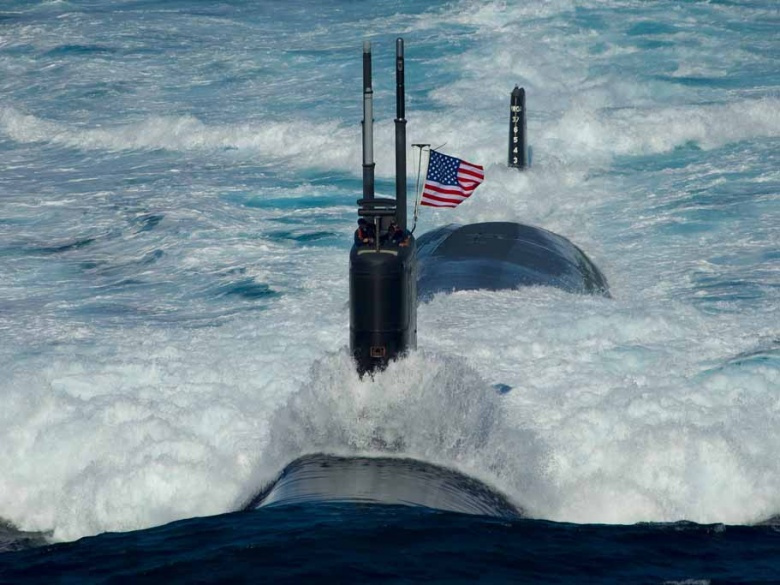
The new Virginia-class submarine North Dakota at the Electric
Boat shipyard in Connecticut. Navy photo
war-is-boring
‘Block V’ attack boat will be cheap but noisy
The U.S. Navy has finally selected which of five candidate designs it will use for its new “Block V” Virginia-class submarines, meant to replace the sailing branch’s existing underwater arsenal vessels starting in around a decade’s time.
According to the U.S. Naval Institute,
the Navy has chosen the least expensive design, helping to ensure the
new boats don’t break an already-strained shipbuilding budget.
That’s the good news. The bad
news is that the cheap design is also the least elegant, and could make
the Block V subs noisier and easier to detect than their predecessor
ships.

Today
the Navy’s roughly 50 attack subs combined can carry 1,200 Tomahawk
cruise missiles for attacking targets on land. More than half of the
Tomahawks are loaded on just four boats: the so-called “SSGN”
conversions of former Ohio-class nuclear ballistic missile submarines.
When
the 1980s-vintage SSGNs wear out in the mid-2020s, the Navy will lose
half its undersea missile arsenal. Thus in 2009, the sailing branch
began studying ways to add more Tomahawks to new Virginia-class submarines planned for construction. Current Virginias carry 12 Tomahawks in launchers fitted vertically to the bow.
Naval
architects with General Dynamics’ Electric Boat in Connecticut,
America’s main sub-builder, came up with five different ways to add four
extra seven-round launchers to the mid-sections of future Virginias, for an additional 28 missiles per boat.
Building
20 of these improved boats at a rate of two per year starting in
2019—Block Vs at first, possibly followed by Blocks VI and VII with
additional features—would nearly make up for the loss of the SSGNs,
restoring the 1,200-missile total by the time the 20th ship enters
service in the mid-2030s.
Each of Electric Boats’ five options for the Block V subs proposed inserting a plug into the Virginia
design’s standard 380-foot hull. There were proposals for 97-, 91-, 88-
and 70-foot plugs. As sketched by the architects, the longer layouts
required the shipbuilder to shrink some internal spaces in order to
squeeze in the mechanism for the missile tubes’ doors without adding to the Virginia’s 34-foot diameter.

But that would be delicate and expensive work. So to keep the cost of a Block V Virginia as
close as possible to the $2.5-billion price of a standard undersea
boat, the Navy opted for the less expensive option of adding an external
protrusion to the sub design’s hull and fitting the door mechanism
inside that.
The
trouble with this so-called “turtleback” structure is that it creates
“hydrodynamic and potential acoustic problems, especially at the higher
speeds,” according to retired Capt. Karl Hasslinger and John Pavlos, writing in the Navy’s official Undersea Warfare magazine.
In other words, the cheap missile plug could make the Block Vs louder … and easier for an enemy to detect by sonar.
That’s because the ideal shape for any submarine is a smooth elongated teardrop, according to P.N. Joubert, who studied submarine design for the Australian Defense Department.
Adding lumps and corners to the teardrop form creates friction and noise. The massive square turtlebacks on Soviet Delta-class
ballistic-missile submarines during the Cold War were a major reason
those boats were fairly easy for U.S. forces to find and track.
Granted,
the Block V’s turtleback is slight. And as Joubert points out, elements
of a submarines “must fit together like a jigsaw puzzle to make a
complete and efficient design.” It’s no use having the quietest-possible
new guided-missile submarines if you can’t afford to build them.

The
US Navy has been procuring Virginia (SSN-774) class nuclear-powered
attack submarines since FY1998. The two Virginia-class boats requested
for procurement in FY2017 are to be the 25th and 26th boats in the
class. The 10 Virginia-class boats programmed for procurement in
FY2014-FY2018 (two per year for five years) are being procured under a
multiyear-procurement (MYP)contract.
The Navy estimates the combined procurement cost of the two Virginia-class boats requested for procurement in FY2017 at $5,408.9 million, or an average of $2,704.5 million each. The boats have received a total of $1,623.3 million in prior-year advance procurement (AP) funding and $597.6 million in prior-year Economic Order Quantity (EOQ) funding. The Navy’s proposed FY2017 budget requests the remaining $3,188.0 million needed to complete the boats’ estimated combined procurement cost. The Navy’s proposed FY2017 budget also requests $1,767.2 million in AP funding for Virginia-class boats to be procured in future fiscal years, bringing the total FY2017 funding request for the program (excluding outfitting and post-delivery costs) to
$4,955.2 million.
The Navy’s proposed FY2017 budget also requests $97.9 million in research and development funding for the Virginia Payload Module (VPM).
The Navy plans to build some of the Virginia-class boats procured in FY2019 and subsequent years with an additional mid-body section, called the Virginia Payload Module (VPM), that contains four large-diameter, vertical launch tubes that the boats would use to store and fire additional Tomahawk cruise missiles or other payloads, such as large-diameter unmanned underwater vehicles (UUVs).
The Navy’s FY2016 30-year SSN procurement plan, if implemented, would not be sufficient to maintain a force of 48 SSNs consistently over the long run. The Navy projects under that plan the SSN force would fall below 48 boats starting in FY2025, reach a minimum of 41 boats in FY2029, and remain below 48 boats through FY2036.
Potential issues for Congress regarding the Virginia-class program include the Virginia-class procurement rate in coming years and the number of Virginia-class boats procured in FY2019 and subsequent years that will be equipped with the VPM.

 The United States Navy is
reexamining how many nuclear attack submarines it will in need in the
coming decades in light of a resurgent Russia and an increasingly
hostile China. Both of those nations are rapidly building undersea
fleets that are challenging the U.S. Navy’s ability to control the
undersea domain.
The United States Navy is
reexamining how many nuclear attack submarines it will in need in the
coming decades in light of a resurgent Russia and an increasingly
hostile China. Both of those nations are rapidly building undersea
fleets that are challenging the U.S. Navy’s ability to control the
undersea domain.
Right now, the Navy has a standing requirement for forty-eight nuclear attack submarines—however, that number was set in 2006 when the international security situation was different. Faced with a Russia that is fielding advanced submarines and a China that is building a larger, but qualitatively inferior undersea fleet, forty-eight American attack submarines will not be enough.
“The security environment has changed a great deal since then, so I’ve commissioned a study to reassess that level this year,” Adm. John Richardson, chief of naval operations, told the Senate Armed Services Committee on March 15.
Richardson points out, however, that during the 2020s the number of attack boats in the fleet will dip below even the current requirement—leaving the Navy with only forty-one attack submarines by 2029. “That’s got us very concerned,” Richardson said. “We’re about able to meet about 50 to 60 percent of combatant command demands right now—so it’s a very high demand asset.”
Secretary of the Navy, Ray Mabus, added that the problem has been long in the making because the service had not built submarines in adequate numbers in previous years. If the Navy fails to build submarines in adequate numbers in the coming years, the attack submarine shortage will continue to get worse. “You just don’t make that up,” Mabus said.
Going forward, Mabus said the Navy is committed to building two Virginia-class submarines per year. However, the Ohio Replacement Program (ORP)—as it is currently structured—will force the Navy to build only one Virginia-class boat per year starting in 2021. The Navy is currently working on a plan to continue building two Virginia-class boats while also building ORP ballistic missile submarines.
The question is whether Electric Boat and Newport News—the two shipyards that build nuclear submarines—have the capability and capacity to build three boats per year. Mabus said that he thinks that shipyards can handle the workload—but funding is the key. “We’re working on how to get the capability and capacity to do two Virginias and the Ohio-class replacement at the same time and I’m confident that’ll be part of the 2018 budget,” Mabus said. “We clearly have the need for the two Virginia-classes.”
However, the ORP program threatens to completely derail the Navy’s shipbuilding budget unless the service gets more funding. “We have to have additional funds for the Ohio-class replacement because. . . it’s a once in a generation thing,” Mabus said. “The two times we’ve done this before . . . we have added additional funds because it is a national level program.”
Richardson’s plan to reevaluate the attack submarine requirement was met warmly not only by the Senate, but also the House Armed Services Committee.
“I strongly support Adm. Richardson’s effort to reevaluate the minimum requirement for attack submarines. The current forty-eight-boat requirement dates from the mid-2000s, and given the growth and activity of China and Russia’s submarine fleets, that requirement is clearly overdue for fresh look,” Rep. Randy Forbes (R-VA), chairman of the House Armed Services Seapower and Projection Forces Subcommittee said in a statement. “We are already on a trajectory that will take us below the old requirement, and I strongly suspect the real requirement is higher still. That’s why I am actively working to find the funding and industrial capacity to build more submarines and sustain out undersea dominance in the years ahead.”
Dave Majumdar is the defense editor for the National Interest. You can follow him on Twitter: @davemajumdar.
Image: Flickr/U.S. Navy.
DARPA’s 130-foot submarine-hunting drone will take to the sea in April
February 15, 2016

After
years of development and construction, the Defense Advanced Research
Projects Agency (DARPA) says it has settled on a proper launch date for
its futuristic submarine-hunting surface drone known as the ACTUV. Officially scheduled for April 7, DARPA’s Anti-Submarine Warfare Continuous Trail Unmanned Vessell
plans to ship out from its Portland, Oregon shipyard and embark on its
maiden voyage in the Pacific Northwest city’s frigid Columbia River.
Once deployed, the rig will undergo standard open water testing before
transitioning to long-range testing in the Pacific for roughly 18
months. After this is completed, DARPA hopes to send the ACTUV on its
first genuine mission by 2017.
In
construction since 2014, DARPA’s 140-ton autonomous vessel was devised
to allow the agency to deliver a long-distance submarine-tracker which
avoids housing even one human. Additionally, the agency created its
internal software with the goal of making its technology as adaptable as
possible in order for it to serve multiple purposes for multiple
agencies.
For
instance, outside of its primary characteristic of tracking and
following even the quietest of submarines over long distances, the U.S.
Navy could also use it to detect mines in the open ocean. Regardless of
its intended function, the ACTUV boasts the potential to continuously
operate for roughly 60 to 90 days, completely on its own.
Please enable Javascript to watch this video
“Imagine
an unmanned surface vessel following all the laws of the sea on its own
and operating with manned surface and unmanned underwater vehicles,”
said DARPA deputy director Steve Walker at a recent media roundtable.
“We think the real cost savings will be in operating this vessel at sea
compared to how we operate vessels today. It could be used for
counter-mine missions, reconaissance, and resupply.”
What’s
perhaps most impressive about the ACTUV’s built-in skills is the fact
it will cost dramatically less to operate than your run-of-the-mill
naval destroyers, running on an estimated $15k to $20k per day instead
of around $200k. DARPA’s ACTUV also has the ability to ship larger
payloads than traditional ship-launched surface vehicles — it is 130
feet long and weighs 140 tons, after all — and will be able to launch
and return to a pier entirely on its own once fully functional.
It’s
unknown whether the official christening will involve broken bottles of
champagne or not, but with the launch scheduled to take place in
Digital Trends’ backyard, expect an in-depth launch report come April 7.
Also watch: Raimond de Hullu’s vision for Oas1s green buildings
Please enable Javascript to watch this video
- The Pentagon looks to laser-equipped UAVs to resurrect its anti-ballistic missile program
- DARPA’s new drone will be able to take off and land on small Navy ships autonomously
- These monstrous deep sea mining robots were built to search for gold on the ocean floor
http://www.popularmechanics.com/
Meet the Navy's New Doomsday Submarine
The next generation in nuclear missile submarines, explained
The Congressional Research Service has
a report on the new class of nuclear ballistic missile submarines,
telling us a little more about these Navy vessels currently under
development, which will carry the nuclear weapons of tomorrow.
Nuclear
missile submarines, which spend months at a time submerged in
classified patrol areas, are considered the most "survivable" of the
so-called nuclear triad (land-, sea-, and air-launched nuclear weapons).
The downside is that they are less accurate than land-based missiles
and tend to be assigned retaliatory missions against "countervalue"
targets—civilian targets such as cities, factories, oil refineries, and
transportation infrastructure. The United States Navy still maintains
14 Ohio-class nuclear missile submarines. Each "boomer" carries 20 Trident D-5 missiles, and each Trident packs up to twelve nuclear warheads, each six times more powerful than the bomb dropped on Hiroshima.
The
next-generation sub—known as SSBN(X)—will enter service in 2031 with
a host of new improvements. One item high on the Navy's wish list is
a nuclear fuel supply that will last the lifetime of the submarine,
allowing the Navy to avoid a costly and time-consuming refueling job two
decades into the ship's tenure. The Navy also wants an electric drive
propulsion system, which will be much quieter than current mechanical
drive systems.
SSBN(X) will be slightly larger than the existing submarines, displacing 20,815 tons, compared to 18,750 tons for the Ohio subs. It will have a beam of 43 feet, making it a foot wider than the Ohio class and nine feet wider than the Virginia class attack submarines.
The
new submarines will carry fewer nuclear missiles than their
predecessors. Each will have launch tubes for 16 Trident D-5 missiles,
for a grand total of 192 tubes spread out between the dozen ships. While
that may not sound like a lot, each Trident can carry up to ten nuclear
warheads. So we're talking about a potential 1,920 nuclear warheads
overall, although the number of deployed warheads is limited by
treaty to 1,090.
All of
this will cost money—a lot of money. The total cost of the SSBN(X)
program is expected to be $95.8 billion, including $11.8 billion in
research and development costs and $84 billion for the submarines
themselves. The first sub is expected to cost a whopping $14.5 billion,
and $4.9 billion a pop for the rest. Consider that most Pentagon
programs inevitably encounter cost overruns of approximately 20 percent
and the true cost of this program boggles the mind.
Is it all of this money just to build a dozen submarines worth it? That's a very good question. It's been 30 years since the Ohio
class was justified, and in that time the Cold War has since ended and
nuclear arsenals around the world have undergone sweeping cuts. Still,
the threat hasn't gone away completely: Putin's Russia has grown
increasingly aggressive and has made modernizing Russia's nuclear
submarine force a top priority.
Correction:
The first SSBN(X) submarine will be purchased in 2021, but won't enter
service until 2031. The article has been revised to correct the dates.
http://nextbigfuture.com/
Navy Virginia (SSN-774) Class Attack Submarine Procurement
The Navy estimates the combined procurement cost of the two Virginia-class boats requested for procurement in FY2017 at $5,408.9 million, or an average of $2,704.5 million each. The boats have received a total of $1,623.3 million in prior-year advance procurement (AP) funding and $597.6 million in prior-year Economic Order Quantity (EOQ) funding. The Navy’s proposed FY2017 budget requests the remaining $3,188.0 million needed to complete the boats’ estimated combined procurement cost. The Navy’s proposed FY2017 budget also requests $1,767.2 million in AP funding for Virginia-class boats to be procured in future fiscal years, bringing the total FY2017 funding request for the program (excluding outfitting and post-delivery costs) to
$4,955.2 million.
The Navy’s proposed FY2017 budget also requests $97.9 million in research and development funding for the Virginia Payload Module (VPM).
The Navy plans to build some of the Virginia-class boats procured in FY2019 and subsequent years with an additional mid-body section, called the Virginia Payload Module (VPM), that contains four large-diameter, vertical launch tubes that the boats would use to store and fire additional Tomahawk cruise missiles or other payloads, such as large-diameter unmanned underwater vehicles (UUVs).
The Navy’s FY2016 30-year SSN procurement plan, if implemented, would not be sufficient to maintain a force of 48 SSNs consistently over the long run. The Navy projects under that plan the SSN force would fall below 48 boats starting in FY2025, reach a minimum of 41 boats in FY2029, and remain below 48 boats through FY2036.
Potential issues for Congress regarding the Virginia-class program include the Virginia-class procurement rate in coming years and the number of Virginia-class boats procured in FY2019 and subsequent years that will be equipped with the VPM.

The U.S. Navy's Master Plan to Rebuild Its Sub Fleet

Right now, the Navy has a standing requirement for forty-eight nuclear attack submarines—however, that number was set in 2006 when the international security situation was different. Faced with a Russia that is fielding advanced submarines and a China that is building a larger, but qualitatively inferior undersea fleet, forty-eight American attack submarines will not be enough.
“The security environment has changed a great deal since then, so I’ve commissioned a study to reassess that level this year,” Adm. John Richardson, chief of naval operations, told the Senate Armed Services Committee on March 15.
Richardson points out, however, that during the 2020s the number of attack boats in the fleet will dip below even the current requirement—leaving the Navy with only forty-one attack submarines by 2029. “That’s got us very concerned,” Richardson said. “We’re about able to meet about 50 to 60 percent of combatant command demands right now—so it’s a very high demand asset.”
Secretary of the Navy, Ray Mabus, added that the problem has been long in the making because the service had not built submarines in adequate numbers in previous years. If the Navy fails to build submarines in adequate numbers in the coming years, the attack submarine shortage will continue to get worse. “You just don’t make that up,” Mabus said.
Going forward, Mabus said the Navy is committed to building two Virginia-class submarines per year. However, the Ohio Replacement Program (ORP)—as it is currently structured—will force the Navy to build only one Virginia-class boat per year starting in 2021. The Navy is currently working on a plan to continue building two Virginia-class boats while also building ORP ballistic missile submarines.
The question is whether Electric Boat and Newport News—the two shipyards that build nuclear submarines—have the capability and capacity to build three boats per year. Mabus said that he thinks that shipyards can handle the workload—but funding is the key. “We’re working on how to get the capability and capacity to do two Virginias and the Ohio-class replacement at the same time and I’m confident that’ll be part of the 2018 budget,” Mabus said. “We clearly have the need for the two Virginia-classes.”
However, the ORP program threatens to completely derail the Navy’s shipbuilding budget unless the service gets more funding. “We have to have additional funds for the Ohio-class replacement because. . . it’s a once in a generation thing,” Mabus said. “The two times we’ve done this before . . . we have added additional funds because it is a national level program.”
Richardson’s plan to reevaluate the attack submarine requirement was met warmly not only by the Senate, but also the House Armed Services Committee.
“I strongly support Adm. Richardson’s effort to reevaluate the minimum requirement for attack submarines. The current forty-eight-boat requirement dates from the mid-2000s, and given the growth and activity of China and Russia’s submarine fleets, that requirement is clearly overdue for fresh look,” Rep. Randy Forbes (R-VA), chairman of the House Armed Services Seapower and Projection Forces Subcommittee said in a statement. “We are already on a trajectory that will take us below the old requirement, and I strongly suspect the real requirement is higher still. That’s why I am actively working to find the funding and industrial capacity to build more submarines and sustain out undersea dominance in the years ahead.”
Dave Majumdar is the defense editor for the National Interest. You can follow him on Twitter: @davemajumdar.
Image: Flickr/U.S. Navy.






No comments:
Post a Comment